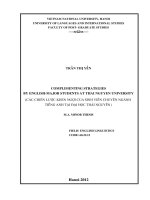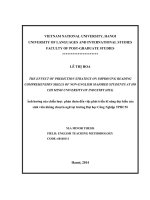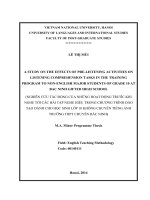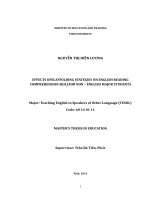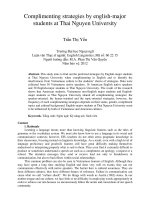Effects of scaffolding strategies on english reading comprehension skill for non english major students
Bạn đang xem bản rút gọn của tài liệu. Xem và tải ngay bản đầy đủ của tài liệu tại đây (2.31 MB, 116 trang )
MINISTRY OF EDUCATION AND TRAINING
VINH UNIVERSITY
NGUYỄN THỊ HIỀN LƯƠNG
EFFECTS OFSCAFFOLDING STATEGIES ON ENGLISH READING
COMPREHENSION SKILLFOR NON – ENGLISH MAJOR STUDENTS
Major: Teaching English to Speakers of Other Language (TESOL)
Code: 60 14 01 11
MASTER’S THESIS IN EDUCATION
Supervisor: Trần Bá Tiến, Ph.D.
Vinh, 2014
1
STATEMENT OF AUTHORSHIP
I hereby acknowledge that this study is mine. The data and findings
discussed in the thesis are true and have not published elsewhere.
Author
Nguyen Thi Hien Luong
2
ABSTRACT
The study attempted to examine effects of scaffolding strategies on reading
comprehension skills for non English major students. It aims to find out students’
difficulties in learning this comprehensive skill, their expectations of teachers’
methodology as well as their attitudes towards scaffolding strategies experimented.
Both qualitative and quantitative research methodology were utilized in this
study. The data was collected through the reading proficiency pretest and posttest,
questionnaires, interviews and six experimental scaffolding strategies. The
participants of the research who were divided into two groups, the control and
experimental groups, included 100 non English major students at Vinh university.
The results from the study revealed that most students encountered
difficulties in all five aspects of languages namely vocabulary, background
knowledge, grammar, discourse structures and reading skills and reading strategies.
Most of the students expressed their expectations in term of teachers’ methodology
such as pre-teaching vocabulary, providing background knowledge and using
appropriate reading strategies. The finding also showed that the reading proficiency
level of non English major students were quite low. However, this was significantly
improved after three months experimental teaching using scaffolding strategies in
reading class. Additionally, all of the students expressed their positive attitudes and
good appreciations for six scaffolding strategies experimented which helped them to
deal with their reading problems.
On the basics of the findings, some pedagogical implications were drawn out
not only for students to become effective readers but also for language teachers and
the educational administrators to enhance students’ reading proficiency. Limitations
of the study were pointed out and further research was suggested.
3
4
ACKNOWLEDGEMENTS
Above of all, I would like to express my deepest thanks to my beloved
supervisor Dr. Tran Ba Tien for his invaluable support, patient guidance, and
encouragement he gave me throughout my research.
I also wish to send my sincere thanks to the students of the classes I taught in
order to experiment scaffolding strategies and gather information for my survey
questionnaire and interview. Without their enthusiastic contribution, this study
could not have been successful.
I am indebted to my friends, my classmates, as well as my colleagues for
their invaluable comments and criticism and also for their continued interest and
encouragement.
Last but not least, I would like to express my gratitude to my family
members who are always beside me, creating favorable conditions and supporting
me both spiritually and materially to complete this thesis.
5
TABLE OF CONTENTS
6
CEFR: The common European Framework of Reference for Languages
CLT: Communicative Language Teaching
DRTA: Directed Reading Thinking Activity
EFL: English as a Foreign Language
ESL: English as Second Language
N: Number
P: Percentage
ZPD: Zone of Proximal Development
LIST OF TABLES AND FIGURES
7
8
1.1. Rationale
Being able to understand what one reads is important for learning in school
and for life in general. In higher education, reading in English as a foreign language
(EFL) requires teachers to explore strategies that can improve students' reading
comprehension. At Vinh University, non-English major students tend to have low
levels of English, which makes reading comprehension challenging. Often,
instructional approaches promote reading as a product rather than as a process. The
former focuses on the text, while the latter explores the readers, their background
knowledge and experience, predictions, and interaction with the text. Additionally,
reading comprehension skills are usually taught in school in one of two ways. One
method is to have students read a text and then read comments or answer questions
about the text. This method stresses important components of reading
comprehension, but treats them purely as products (i.e., interpretations) rather than
as processes (i.e., constructing interpretations). In particular, it does not teach
students what to do when they have difficulty comprehending parts of the text;
nor does it teach them how to construct and revise hypotheses about what is
likely to occur in the text based on what they have already read. Both of these
aspects are important in constructing an interpretation of the text. In an effort to
find an effective method of teaching reading skills, recent researches emphasize
learning by engaging learners in knowledge construction (Reiser, 2004). The
conditions of meaningful learning require appropriate strategies, where students
need to elaborate, or generate activities, such as self- questioning, semantic
mapping, and summary writing, monitor learning, and construct meaning from a
reading text. Such strategies can be considered effective in reading
comprehension (McGriff, 1996). If provided with appropriate assistance,
students can attain a goal or engage in a practice task that is beyond their reach.
Reiser (2004) points that with scaffolding strategies, learners receive support and
assistance to successfully perform certain tasks and move to more complex ones.
Similarly, Vacca (2008) suggests that when guided, supported and provided with
9
the necessary attributes, students become more responsible for their learning,
more motivated, and more successful. Scaffolding strategies are, therefore,
effective for teaching reading , and such strategies influence the development of
higher functions and skills beyond the confines of learner.
With more than 3 years of experience in teaching English at Vinh University,
I found that EFL learners face serious problems in comprehending facts stated or
implied in an English context; they are unable to realize the main ideas of given text
as well as reflect on the author’s purpose of writing. Moreover, they find
themselves confronted with a vast variety of information, vocabulary, grammatical
structures, culture aspects, and resources that make it extremely hard for them to
pick their ways through. Consequently, if the teachers do not teach scaffolding
strategies, the better students will develop them on their own, and the worse ones
will find reading very frustrating.
All the aforementioned reasons urge the author to carry out the study entitled
“Effects of scaffolding strategies on English reading comprehension skills for non-
English major students”. Hopefully, the results could serve as a useful source of
reference for those who are concerned about the subject matter.
1.2. Aims of the study
With the presented rationale, the specific aims of the study, accordingly, are:
1) to investigate the difficulties faced by non English major students in
learning reading skill?
2) to evaluate the effectiveness of the application of scaffolding strategies to
improve reading comprehension for non- English major students.
3) to propose some suggestions and recommendations to reading
comprehension teaching and learning .
1.3. Scope of the study
This research focuses on investigating how scaffolding strategies affect
reading comprehension skills at Vinh University. Due to the limitation of time, the
10
author only fulfilled the study among one hundred non English major students at
Vinh University. We also choose to focus on some scaffolding strategies namely
background knowledge activation, pre-teaching vocabulary, using mind maps,
information transfer, using visual aids¸ and previewing the text.
1.4. Research Questions
In order to serve the aforesaid aims, the research attempts to answer the
following questions:
1. What difficulties do non-English major students encounter in learning
reading comprehension skill?
2. How effective are scaffolding strategies in teaching English reading
comprehension skills for non- English major students?
1.5. Significance of the study
The study is expected to be a good reference for teachers and students to
improve students’ reading comprehension skills. In addition, it is also hoped that the
findings of this study will contribute to further understandings of scaffolding
strategies in improving this receptive skill. Moreover, through this study, teachers,
along with their students, will become more aware of the crucial role of scaffolding
strategies, and be able to use those strategies appropriately to their learning
requirements.
1.6. The organization of the study
The study includes five chapters as follows:
Chapter 1 – Introduction – provides the rationale, the aims of the study, the
scope of the study, the research questions, the significance of the study, and the
organization of the study
Chapter 2 – Literature Review and Theoretical Background – presents the
review of previous studies related to the thesis and some concepts as theoretical
basis for the study.
11
Chapter 3 – Research Design and Methodology – describes the research
design, instruments for data collection, data collection, data analysis, and research
procedures, which gives details of the research method and describes how the
hypothesis of the thesis is interpreted and explained.
Chapter 4 – Findings and Discussions – presents the results and discussions
developed after the linguistics figures are analyzed.
Chapter 5 – Conclusion and Implications – summarizes the main issues
touched upon in the research, the limitations of the research and some suggestions
for further studies. Following the chapters are the references and appendices.
12
CHAPTER 2: THEORETICAL BACKGROUND
2.1. Introduction
With the aim of providing a theoretical background to this study, the chapter
also provides a literature review which focuses on previous studies related to the
present research. It then discusses theoretical issues most relevant to the research:
communication language teaching approach, nature of reading, the process of
learning and teaching reading skill, Zone of Proximal Development (ZPD),
scaffolding, and scaffolding strategies.
2.2. Literature review
In the process of teaching and learning English as a foreign language,
reading is considered as an important component because it provides input
language. Assuming its importance, in past years, many educators and scholars have
given greater attention to reading comprehension (e.g. Ben Davis, 2002; Bowman,
1998; Hendricks, et al., 1996; Stauffer, 1957). Some of the ideas put place on the
factors that affect reading comprehension and proposed possible solutions to
improve learner’s reading comprehension. Stauffer (1976) listed some techniques
that teachers should use to teach reading as a thinking process. He also proposed
Directed Reading Thinking Activity (DRTA) to involve reading for a purpose
determined by the students. DRTA helps students develop skills in reading and
thinking. It encourages risk-taking via prediction. Allan Collins and Edward E.
Smith (1980) indicate that current methods for teaching reading comprehension
tend to emphasize the products of comprehension, and neglect the process of
comprehension. They also suggest two sets of processing skills to teach are
comprehension monitoring skills and hypothesis formation and evaluation.
In term of scaffolding reading comprehension skills, a great number of
studies have been conducted in order to find out an effective model in teaching and
learning this comprehensible skill. Arthur. N, Langer and Judith A (2003) discussed
13
a model for teaching reading and writing in which skilled language users provide
support for new language activities in context. They also gave examples of typical
classroom activities that provide too little or too much support for natural language
growth and of activities with balanced instructional "scaffolding." Graves, Michael;
Graves, Bonnie in the book entitled “Scaffolding Reading Experiences: Designs for
Student Success” offered practical examples, updated listings of quality
children's literature, and new activities to promote successful reading
experiences for K-8 learners. The book contains practical information on pre
reading, during reading, and post reading activities, along with ideas for
incorporating scaffolding reading experiences into the classroom. Margaret M.
William (2013) found that learning to read and comprehend fiction and non-
fiction text in a foreign language is a complicated task. Teachers, therefore, can
scaffold, i.e., providing needed support or accommodation for the
comprehension skills that will help English language learners to reach a better
understanding of what they are reading. He also suggested some of scaffolding
strategies such as: activating students’ prior knowledge; using read aloud to
support reading comprehension; making comprehension learning tangible…
A more specific study of scaffolding is presented by Donovan and Smolkin
(2002). They take a critical look at the issue of scaffolding in children's writing.
They research the role of different levels of scaffolding in children's understanding
and demonstration of their knowledge of genre. Tasks range from those that provide
minimal or low level support to those that provide middle or high levels of support
(contextual and visual support). Interestingly, the highest level in their range of
scaffolding is described as a "direct instruction with revision" (Donovan &
Smolkin, 2002, p. 435). Their research revealed, however, that while scaffolding
can assist children it may also, at times, hinder children in demonstrating their full
range of genre knowledge (Donovan & Smolkin, 2002, p. 428). This finding
confirms our concern that scaffolding, when understood as direct instruction, might
14
become counterproductive. Furthermore, some texts for pre-service educators also
refer to direct instruction as at the highest level of scaffolding (Berk, 2000, p. 261).
Some other texts focus on the techniques of scaffolding as various forms of
adult support: demonstration; dividing a task into simpler steps; providing
guidelines; keeping attention focused (McDevitt & Ormrod, 2002) as well as
providing examples and questioning. Breaking content into manageable pieces also
seems to be a common feature of scaffolding that has been emphasized in the texts
(McDevitt & Ormrod, 2002; Krause et al., 2003).
The most recent work on scaffolding and its relationship with students’
performance in reading comprehension is that of Pishghadam and Ghardiri (2011).
They compared the effects of Symmetrical (S) and Asymmetrical (AS) scaffolding
on reading comprehension of adult learners of English as a foreign language. The
study was conducted on 52 participants, who were learners in one of the English
language institutes in Mashhad, Iran. The results of the study revealed that the
groups’ performance varied on reading comprehension and results indicated that
better performance of students who received instructions through the AS
scaffolding strategy, whereas the students of the S group had the lower mean on the
post-test. The interviews revealed that most of the respondents highly preferred to
have a partner and read in pair for psychological reasons. In addition, most
respondents were believed that their presence would enhance their. However, some
respondents took a more moderate view, stating that it is ok to work with a less
capable peer to share information and experience with him.
In can be seen that most researchers mentioned focused on studying how
scaffolding strategies are effectively used in teaching reading comprehension skills.
In sum, it can be concluded that scaffolding literacy enhances students’ self-
confidence, self-regulation, improves critical thinking and higher order skills and
has an impact on the students’ progress and teaching practices.
In the context of Vietnam, many studies have put emphasis on the teaching
and learning reading skill. Huynh Thi Mong Thuong (2009) conducted a study on
15
the impacts of pre-reading strategies instruction on Hung Vuong High School
student’s reading skill. The author pointed out that pre-reading strategy such as
semantic mapping, skimming for the main ideas, scanning for details… have a
positive effect on reading comprehension skills. Nguyen Thi Trinh Huyen (2009)
investigated reading strategies of non-major English students at An Giang
University. In her study, the findings showed that non major English students tend
to pay a little attention to strategies used during reading comprehension process.
This author also suggested some reading strategies to improve reading
comprehension skill
In summary, the above researchers have considerably contributed to
improving the teaching and learning reading skills in some aspects. However, since
the term “scaffolding” was introduced in teaching methodology, there still have
been no studies on the effects of scaffolding strategies in reading comprehension
skills. Therefore, the researcher of this thesis finds it essential to conduct the study.
2.3. Theoretical Background
2.3.1. Communicative Language Teaching
Also called Communicative Approach, Communicative Language Teaching
(CLT) is an approach to the teaching of second and foreign languages, emphasizes
interaction as both the means and the ultimate goal of learning a language.
Historically, CLT has been seen as a response to the Audio- Lingual Method and
the Situational Language Teaching method which were questioned by prominent
linguistics like Chomsky (1957) during the 1960s. This linguist rejected the
structuralist view of language and demonstrated that there is a distinction between
performance and competence. For Chomsky the focus of linguistics was to describe
the linguistic competence that enables speakers to produce grammatically correct
sentences. Dell Hymes held, however, that such a view of linguistic theory was
sterile and that it failed to picture all the aspects of language. He advocated the need
of a theory that incorporates communication competence. It must be a definition of
what a speaker needs to know in order to be communicatively competent in a
16
speech community. Later, Canale and Swain (1980) described four dimensions of
communicative competence as follow:
• Grammatical competence: refers to what Chomsky calls linguistic competence,
in other words, the speaker is able to use a structured comprehensible utterance
(including grammar, vocabulary, pronunciation and spelling).
• Sociolinguistic competence: refers to an understanding of the social context in
which communication takes place (role relationships, shared beliefs and information
between participants …)
• Discourse competence: refers to the interpretation of individual messsage
elements in terms of their interconnectedness and how meaning is represented in
relationship to the entire discourse or text.
• Strategic competence: refers to the coping strategies that participants use to
initiate terminate, maintain, repair and redirect communication
At the level of language theory, CLT has a rich theoretical base. Some of the
characteristics of this communicative view of language can be outlined as follows:
1. Language is a system for the expression of meaning.
2. The primary function of language is to allow interactions and communication
3. The structure of language reflects its functional and communicative uses.
4. The primary units of language are not merely its grammatical and structural
features but categories of functional and communicative meaning as exemplified in
discourse.
Nunan (1991) gave a list of most recognized five features of CLT:
1. An emphasis on learning to communicate through interaction in the target
language.
2. The introduction of authentic texts into the learning situation
3. The provision of opportunities for learners to focus, not only on language but also
on the learning process itself.
17
4. An enhancement of the learner’s own experiences as important contributing
elements to classroom learning.
5. An attempt to link classroom language learning with language activities outside
classroom.
In summary, CLT has gained widespread acceptance in the world of
language study. CLT can succeed, providing that teachers don’t completely reject
the need for the structure provided by grammar. In other words, CLT, in the hands
of a balanced teacher, can bring new life and joy to the classroom. Its vitality makes
it an important contributor to language learning approaches.
2.3.2 The teaching of reading
2.3.2.1. The nature of reading
Being considered a receptive language skill, reading, according to Goodman
(1971, p. 135), is “a psycholinguistic process by which the reader - a language user,
reconstructs, as best as he can, a message which has been encoded by a writer as a
graphic display”. The traditional method considered reading as a passive process
and neglected the role of readers as well as their background knowledge and
strategies. Current views, however, states that reading is an active process in which
readers relate information in the text to what they already know. The
comprehension of a written text is the result of the interaction between knowledge
of the world and various types of the language knowledge. Reading comprehension,
therefore, is the ability to retain information of a written text to the fullest of the
readers. Grellet defines that “reading comprehension or understanding a written text
means extracting the required information from it as effectively as possible”
(Grellet, 1981, p. 34). From this point of view, Grellet focuses on readers’ ability of
understanding the meaning of a written text based on the individual’s background
knowledge. Having the same point of view with Grellet, Swan states that “A student
is good at comprehension we mean that he can read accurately and efficiently, so as
to get the maximum information of a text with the minimum of understanding”
(Swan, 1975, p. 1). This means that the student can show his understanding by re-
18
expressing the content of the text in many ways such as summarizing the text,
answering questions, etc.
2.3.2.2 The process of teaching and learning reading comprehension skills
2.3.2.2.1. The bottom –up reading process
Bottom-up theories hypothesize that learning to read progresses from
children learning the parts of language (letters) to understanding whole text
(meaning). Much like solving a jigsaw puzzle, bottom-up models of the reading
process say that the reading puzzle is solved by beginning with an examination of
each piece of the puzzle and then putting pieces together to make a picture. Two
bottom-up theories of the reading process remain popular even today: One Second
of Reading by Gough (1972) and A Theory of Automatic Information Processing by
LaBerge and Samuels (1974). Gough’s (1972) One Second of Reading model
described reading as a sequential or serial mental process. Readers, according to
Gough, begin by translating the parts of written language (letters) into speech
sounds, and then piece the sounds together to form individual words, then piece the
words together to arrive at an understanding of the author’s written message.
Teachers who believe that bottom-up theories fully explain how children become
readers often teach subskills first: they begin instruction by introducing letter names
and letter sounds, progress to pronouncing whole words, then show students ways
of connecting word meanings to comprehend texts. Although bottom-up theories of
the reading process explain the decoding part of the reading process rather well,
there is certainly more to reading than decoding. To become readers, students must
compare their knowledge and background experiences to the text in order to
understand the author’s message. Also called date- driven reading process, this
method obviously requires a sophisticated knowledge of the language itself. From
among all the perceived data, the reader selects the signals that make some sense,
that cohere, that “mean”. Stanovich (1980) states that an important shortcoming of
this model is the fact that it is difficult to account for sentence-context effects and
the role of prior knowledge of text topic as facilitating variables in word recognition
19
and comprehension (because of lack of feedback). According to Swan (1973), the
decoding model is inadequate because it underestimates the contribution of the
reader who makes predictions and processes information. It fails to recognize that
students utilize their expectations about the text, based on their knowledge of
language and how it works. Goodman (1970) claims that all reading involve a risk-
a guessing game- because readers must, through a puzzle- solving process, infer
meanings, decide what to retain and what not to retain and move on. This is where a
complementary method of processing written text is imperative: top-down, or
conceptually- driven, processing in which we draw on our own intelligence and
experience to understand a text.
2.3.2.2.2 The top- down reading process
Top-down reading models teach students to read by introducing them to
literature as a whole. Instead of teaching students to read by sounding out each
word in a sentence, teachers read whole passages of a text. Students begin to use
context clues to decipher unfamiliar words. The National Capital Language
Research Center reports top-down reading models are helpful to those learning a
second language because they help students concentrate on the whole meaning of a
passage. The theory also works with those just learning to read, as readers rely on
their previous knowledge to decipher text or unfamiliar words. This reading process
begins with the reader’s hypothesis or predictions about the text he or she is going
to read. The reader, afterwards, reads and checks whether or not his or her
predictions are correct. This method is, therefore, a process of constructing
interpretations rather than decoding forms and the reader only turns to decoding if
necessary, that is, if other means fail. The advantage of top- down reading process
is it considers the reader an active participant in the reading process From earlier
views of SL reading as a passive linguistic decoding process (bottom-up) to more
contemporary views of SL reading as an active predictive process. However, one of
shortcomings of this method, according to Stanovich (1980) is for many texts, the
reader has little knowledge of the topic and cannot generate predictions. Even if a
20
skilled reader can generate predictions, this would take much longer than it would
to recognize the words. Strang (1984), therefore, claims that a top-down model of
reading is essentially a model of the fluent reader and does not account for all the
needs of students who are acquiring reading skills. These limitations of top-down
model make reading specialists find out a compensatory approach which is called
interactive reading (Stanovich)- a combination of top- down and bottom- up
processing. The interactive reading is almost a primary ingredient in successful
teaching methodology because both processes are important. “In practice, a reader
continually shifts from one focus to another, now adopting a top- down approach to
predict probable meaning, then moving to the bottom- up approach to check
whether that is really the writer says” (Nuttall, 1996, p. 17).
2.3.3. Zone of Proximal Development (ZPD) and Scaffolding
2.3.3.1. Zone of Proximal Development
The zone of proximal or potential development perhaps is the best known
concept of Vygotskian socio-cultural psychology. Vygotsky defines Zone of
Proximal Development (ZPD) as “the distance between the actual development
level as determined by independent problem solving and the level of potential
development as determined through problem solving under adult guidance, or in
collaboration with more capable peer” (1978, p. 86). Initially, it was elaborated for
psychological testing in schools (Vygotsky, 1962). Vygotsky stated that testing
should be based not only on the current level of a child's achievements but also (and
mainly) on the child's potential development. The actual level of development (level
of independent performance) does not sufficiently describe development. Rather, it
indicates what is already developed or achieved; it is a “yesterday of development”.
The level of assisted performance indicates what a person can achieve in the near
future, what is developing (potential level, “tomorrow of development”, what a
person “can be”) (Vygotsky, 1978). Thus, the zone of proximal development is the
distance between what a person can do with and without help. The term proximal
(nearby) indicates that the assistance provided goes just slightly beyond the
21
learner’s current competence complementing and building on their existing abilities
(Cole & Cole, 2001).
The concept of the ZPD can be fully understood only in the context and as
part of Vygotskian theory on the whole. "In fact, failure to see the connections
between the zone and the theory as a whole means that it is difficult to differentiate
Vygotsky's concept from any instructional technique that systematically leads
children, with the help of an adult, through a number of steps in the process of
learning some set of skills" (Cole & Cole, 2001).
There is a consensus that Vygotskian socio-cultural psychology and the
notion of the zone of proximal development are at the heart of the concept of
scaffolding (Berk, 2001; Daniels, 2001; Wells, 2001; McDevitt & Ormrod, 2002).
However, the interpretations and explanations of the exact ways that scaffolding
relates to it have been different. These range from understanding scaffolding as a
direct application and operationalization of Vygotsky's concept of teaching in the
zone of proximal development (Wells, 1999), to the view that the notion of
scaffolding only partially reflects the richness of Vygotsky's zone of proximal
development ( Daniels, 2001).
Mercer and Fisher (1993, in Wells, 1999) view the ZPD characteristic of
transfer of responsibility for the task to the student as the major goal of scaffolding
in teaching. In order to qualify as scaffolding, they propose, a teaching and learning
event should: a) enable the learners to carry out the task which they would not have
been able to manage on their own; b) be intended to bring the learner to a state of
competence which will enable them eventually to complete such a task on their
own; and c) be followed by evidence of the learners having achieved some greater
level of independent competence as a result of the scaffolding experience (Wells,
1999, p. 221). The emphasis of their definition is on the collaboration between the
teacher and the learner in constructing knowledge and skill in the former.
Field (2004) describes the relationship between scaffolding and ZPD as
follow: An adult provides help to a developing child by way of prompting his
22
attention in a task, guiding him toward appropriate goals, marking prominent
features of a task and showing related strategies. Scaffolding has a significant role
in supporting a child to progress into his ZPD. ZPD provides educational experts a
clear and a simple guideline about how to support learners at each learning stage.
2.3.3.2. Scaffolding strategies
In education, scaffolding refers to a variety of instructional techniques used
to move students progressively toward stronger understanding and, ultimately,
greater independence in the learning process. The term itself offers the relevant
descriptive metaphor: teachers provide successive levels of temporary support help
students reach higher levels of comprehension and skill acquisition that they would
not be able to achieve without assistance. Like physical scaffolding, the supportive
strategies are incrementally removed when they are no longer needed, and the
teacher gradually shifts more responsibility over the learning process to the student.
Scaffolding is widely considered to be an essential element of effective
teaching, and all teachers—to a greater or lesser extent—almost certainly use
various forms of instructional scaffolding in their teaching. In addition, scaffolding
is often used to bridge learning gaps—i.e., the difference between what students
have learned and what they are expected to know and be able to do at a certain point
in their education. For example, if students are not at the reading level required to
understand a text being taught in a course, the teacher might use instructional
scaffolding to incrementally improve their reading ability until they can read the
required text independently and without assistance. One of the main goals of
scaffolding is to reduce the negative emotions and self-perceptions that students
may experience when they get frustrated, intimidated, or discouraged when
attempting a difficult task without the assistance, direction, or understanding they
need to complete it.
Wood, Bruner and Ross (1976, p. 90) define scaffolding as “A process that
enables a child or a novice to solve problem, carry out a task, or achieve a goal
which would be beyond his unassisted efforts”. They coin the term scaffolding as a
23
metaphor to describe the effective process by which an adult, a peer, or a competent
person assists a child to perform a task beyond his or her current capability. Since
then, a great number of educational specialists and experts have used the concept to
describe and explain the role of adults or more knowledgeable peers in guiding
children’s learning and development (Stone, 1998; Wells, 1999; Hammond, 2002).
Scaffolding, however, can be traced to Vygotsky’s (1978) concept of “the zone of
proximal development (ZPD)”, which is the actual developmental level of the
learner compared with the level of potential development that can take place with
guidance or collaboration with a more competent person. It directs attention to the
need for support in the learning process, and does so in a way that emphasizes that
excellence in teaching is necessarily responsive to the state of understanding
achieved by particular learners. In computer mediated technologies, a human tutor,
peer students or intelligent agents can provide scaffolding so that learners could
attain new skills, concepts and knowledge (Mc Loughlin, 2004)
One of the most common questions that a responsible teacher may pose to
himself is “What are the most beneficial strategies for my struggling readers?”. In
fact, by scaffolding reading instruction with various strategies, you will improve the
reading abilities of most students. The key is to apply reading strategies persistently
and imaginatively. As with any new skill, these reading strategies should be taught
through a scaffolding method, which includes modeling the strategy, providing
students with opportunities for guided practice with strategy, and then having
students independently apply the strategy. Because students have different reading
styles, they are not likely to find all reading strategies equally useful. While a
particular strategy may reinforce strength that one student has or may provide the
key to overcoming a reading difficulty, the same strategy may prove to be tedious
or useless to another student. For this reason, the explicit teaching of reading
strategies should also include opportunities for students to reflect on the
effectiveness of the strategy. By considering questions such as:
- How does this strategy help me to understand the text?
24
- How does this strategy relate to something I already do or don't do as a reader?
- How might I use this strategy with texts from other subject areas?
students will become increasingly aware of the strategies that help them to read
more effective. Strategies, in their turn, make students become active learners and
therefore, their zone of proximal development can be maximized through the help
of their peers and teacher. Scaffolding, however, should be temporarily provided
and it is gradually removed bit by bit as the learners become more competent
independently (Collins, 2004). From my own experience in teaching English, I have
found some useful scaffolding strategies which can activate and stimulate students
in learning reading comprehension skills as follow:
2.3.3.2.1. Prior knowledge activation
Widely used as a before reading strategy, Prior Knowledge Activation was
suggested in the literature by knowledgeable researchers. According to Rumelhard
(1994), activating background knowledge for learning involves helping English
learners make “connection between their own knowledge and experiences and the
new information being taught”. Cummins (2009) affirms that activating and
building prior knowledge help ESL (English as Second Language) students learn
content, and suggests strategies such as brainstorming or discussion, using both
visuals and graphic organizers. Similarly, Carrel (1988, p. 245) suggests numerous
ways in which relevant schemata may be constructed: visual aids, demonstrations,
discussions, role-play, text-previewing, key vocabulary, key word/key concept
association activities, questioning and brainstorming. Research has shown that
comprehension can be improved when a reader’s relevant prior knowledge is
activated before reading (Nunan, 1991). By assisting students to recall knowledge
needed for a given text, the teacher helps them in building bridges from the new to
the known. Prince (1987) found that comprehension was even improved by
conducting certain enrichment activities before reading rather than afterward.
Comprehension is also enhanced by adding important background knowledge that
students lack. Carell (1988) affirms that "Activating prior knowledge is something
25



